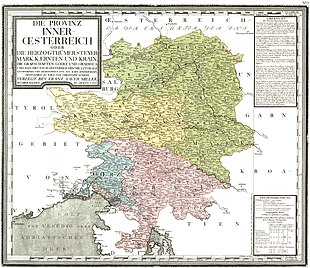Inner Austria
|
Territory in the Holy Roman Empire |
|
|---|---|
| Inner Austria | |
| coat of arms | |

|
|
| map | |

|
|
| “Inner Austria” remained a common term even after the administrative unit was dissolved, here: at the end of the 18th century
|
|
| Arose from | Hztm. Styria , Carinthia , Carniola and the coastal region |
| Form of rule | Lieutenancy |
| Ruler / government | Archduke of Austria / governor |
| Today's region / s | AT / IT / SI
|
| Reichskreis | Austrian Imperial Circle |
| Capitals / residences | Graz |
| Dynasties | Habsburg , Habsburg Inner Austria |
| Denomination / Religions | Catholic |
| Language / n |
Bavarian , Slovenian , Furlanic
|
| Incorporated into | (same)
|
Inner Austria is a comprehensive name for the countries south of Semmering , that is, the duchies of Styria , Carinthia , Carniola and the coastal region . As a political unit it existed in the course of the Habsburg inheritance divisions 1379 / 1411-1457 and 1564-1619, residence was Graz .
The name became common in the middle of the 15th century, as a contrast to the federal states of Lower Austria (Austria proper, i.e. Austria above the Enns / Upper Austria and Austria under the Enns / Lower Austria) and the federal states of Upper Austria (i.e. Tyrol and the foreland ) .
The first division took place between the Leopoldine and Albertine lines , after Albrecht III. with the braid and Leopold III. the Righteous , the sons of Albrecht II the Wise , on the Neuberg partition contract of September 25, 1379 - and the following redistributions in 1395/6 ( Treaty of Hollenburg ) , 1406 (death of Wilhelm the ambitious / friendly ) and 1411 (death of Leopold the Dicken ). The first Habsburg to reside in Graz was Ernst der Eiserne , also his son Emperor Friedrich III. resided there again and again.
In the course of the second division of the estate in 1564 among the sons of Ferdinand I , the youngest son Karl II received this land complex. This was organized as a separate sovereignty, which above all also had its own war authority. This had the task of border protection against the Ottoman Empire and was therefore only moved to Vienna in 1705. The establishment of the military border was organized from Graz.
After Ferdinand III. of Inner Austria under the name Ferdinand II. 1619 became emperor and sovereign of the Bohemian (1617, with interruption) and Lower Austrian states, the state complex gradually merged into the overall Habsburg empire . A governor of Inner Austria as an intermediary authority for the individual countries, however, persisted until the time of Maria Theresa . Also, for example, the scope of their Constitutio Criminalis Theresiana is given as “everyone in our royal-Bohemian, as well as lower, inner, upper and front-Austrian hereditary lands”.
Dukes / Archdukes in Inner Austria
from the Leopoldine line :
- Leopold III, the Righteous (1351–1386), Duke of Austria, then of Inner Austria
- Wilhelm the Ambitious , 1396–1406, Duke in Inner Austria
- Leopold IV, the Fat , 1406–1411
- Ernst, the Iron 1411-1424
- Frederick V from 1435, Emperor (III.) From 1452–1493; in 1457 he inherited the remaining Habsburg lines.
from the Habsburg-Inner Austria line :
-
Charles II. 1564-1590
- Ernst [II.] , Governor 1590–1593
- Maximilian III , Governor 1593–1595
- Ferdinand II , 1590 or 1595 (1619–1637 emperor), inherited all Habsburg lines
Colloquial use
In the 20th and 21st centuries, residents of Vorarlberg used the term Inner Austria as an allusion to the geographic location and the affiliation of Vorarlberg to the old Upper Austria in the meaning of "Austria without Vorarlberg" or "Austria without Vorarlberg and Tyrol".
literature
- France M. Dolinar (Ed.): Catholic Reform and Counter-Reformation in Inner Austria 1564–1628 . Hermagoras, Klagenfurt 1994, ISBN 3-85013-358-3 .
- Werner Drobesch, Peter G. Tropper (Ed.): The Jesuits in Inner Austria. The cultural and intellectual character of a region in the 17th and 18th centuries . Hermagoras, Klagenfurt, Vienna 2006.
- Joseph Karl Kindermann, Keresztély Junker, Gerhard Michael Dienes: Atlas of Inneroesterreich. The province of Inner-Austria or the duchies of Steyermark, Kaernten and Krain, the counties of Goerz and Gradisca and the German-Austrian littoral . Archiv-Verlag, Vienna 2005 (reprint based on the orig. Cards from the years 1789–1797).
- Alexander Novotny (Red.): Inner Austria 1564–1619 . Styrian regional government, Graz 1967.
- Christa Schillinger-Prass, Ilse Brehmer: Education for girls in Inner Austria . Steiermärkisches Landesarchiv, Graz 2000, ISBN 3-901938-03-6 .
historical monographs:
- Ignaz de Luca: The Archduchy of Austria. 1. Volume of the Geographical Handbook of the Austrian State. Verlag Joseph V. Degen, Vienna 1791, Inneröstreich , pp. 555-574 ( Google eBook, complete view ; more detailed descriptions in each case in volume 2. The countries located in the Austrian district ).
Web links
Individual evidence
- ^ Judgment of the Supreme Court of June 15, 1988, 9 ObA 126/88.
- ↑ Parliamentary question in the Bundesrat 2048 / J-BR BR of 23 December 2002.